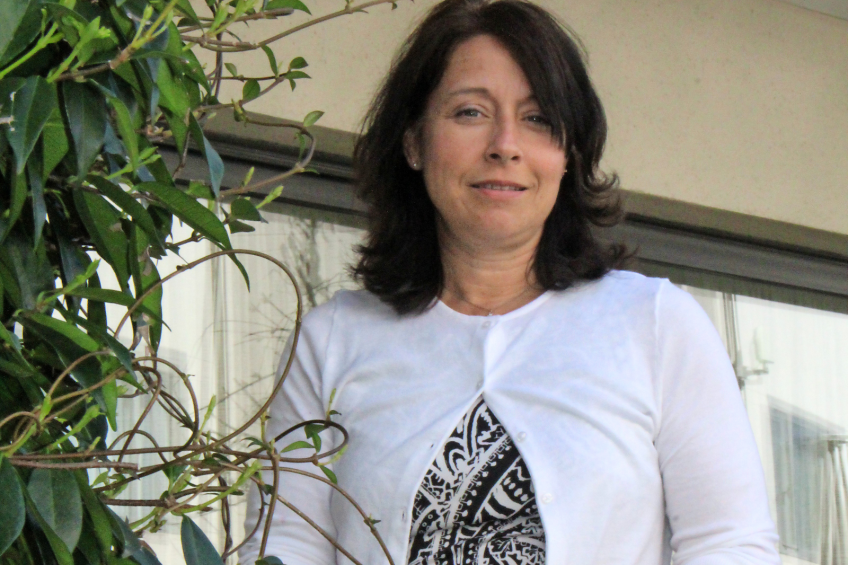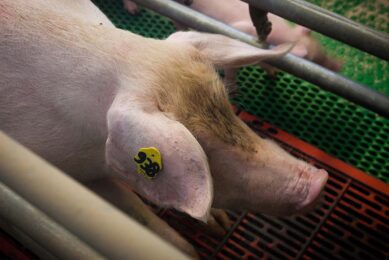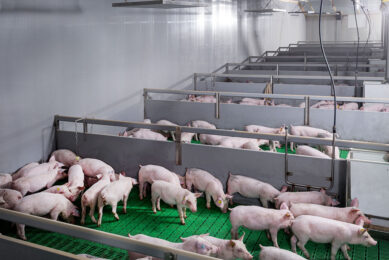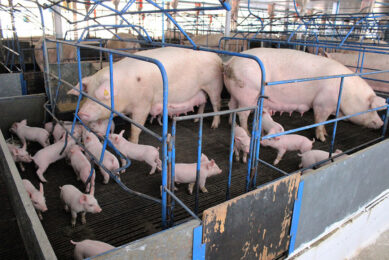“Not all stress is bad”

Stress is not necessarily a bad thing for pigs. After all, if a pig feels threatened, hungry or cold, it can take action. Now what exactly is stress, why is it so interesting, and when is stress bad for pigs? Prof Janeen Salak-Johnson, stress expert at Illinois University, explains.
Pigs and behaviour – two subjects Prof Janeen Salak-Johnson was only moderately interested in when she embarked on her undergraduate at Texas Tech University. Nevertheless, nowadays, these two words are among the most important in the toolkit of her current expertise. As associate professor at the University of Illinois’ Department of Animal Sciences, her major field of interest is stress, as well as environmental physiology and well-being.
Now often lecturing and speaking on pig behaviour, she tells Pig Progress: “It’s ironic, because I’ve never taken a behaviour class. When students come to me at the University of Illinois and say I’m interested in behaviour, I have to tell them that behaviour is a tool for me: the biological response. Just because animals’ behaviour changes, does not mean they are unhappy. It is a way of trying to deal with the stressor. That is probably the only reason that I use behaviour in a lot of my research.”
Behaviour as a tool to study the phenomenon of stress – some nice examples became clear at a recent Feet First symposium organised by Zinpro Performance Minerals. She explained how stress levels in sows can affect their progeny, by presenting recent results of trials in which sows were placed in situations with extra light, a meal with probiotics and different levels of in-feed fibre.
She also presented a ‘simplistic model of animal stress’: there is a stimulus, leading to an altered biological function with an animal. From there, either the animal resumes its normal biological function; or the stimulus is changed, or it is the onset of pathology.
Pig Progress: Why is stress fascinating to you?
Prof Janeen Salak-Johnson: “Stress is fascinating because it’s always been viewed negatively, yet animals and people need ‘stress’ in their lives. On the other hand, I am not so sure per se that it is truly stress that is fascinating or intriguing, it’s more the ability of the animal to adapt and cope with stress with minimal consequences in terms of animal well-being.”
You distinguish between acute stressors and chronic stressors. What exactly is the difference?
“Chronic is really longer-term; when we talk about acute stress, we really talk about something that is hours or days. In chronic stress we’re talking more about weeks and beyond. For pigs, think of subclinical disease, and water or air quality.
“If we talk about chronic stress in the pig industry it would most likely be found in sows or even boars. Most often wean-to-finish pigs experience very little chronic stress, unless they are truly being bullied and someone doesn’t recognise that.”
Is the concept of stress underestimated in the pig industry?
“Yes, most definitely! It really is the basic concept to understanding animal-environment interactions. I truly think that the lack of understanding and the ability to apply the concept of stress to the pig industry is one of the reasons the pig industry faces animal welfare issues.”

Photo: Vincent ter Beek.
When did you realise the pig industry had a future for you?
“It really was by accident. I originally thought I wanted to be a vet, just like most other individuals. When I was working on my undergraduate degree, I was much more interested in stress at that time, an area where John McGlone was moving some of his research. In his lab some of the first research specifically related to the pig and the immune system was being conducted. That was how I got intrigued – and I never left.”
Why is animal behaviour a tool to study stress?
“I was trained as someone who knew that you’d have to use multiple metrics. You can’t just use behaviour, you can’t just use the immune system, you can’t just use growth and performance. It’s because all these biological systems are used by the animal to cope with the stressor. Sometimes little changes are enough to help the animal cope. If they cope, they are just fine.
“An example from my data: short-day light activates the immune response for 14-day old pigs, but guess what, it costs them in growth. And that was a long-term effect, all the way up to 140 days. If we hadn’t measured that, what would we would have said? ‘Short days improve the immune status of an animal, so put all your 14-day old pigs on short days when you wean them’.
“That’s why studying stress is so frustrating. Early on, people would only use one measure. The old dogma is ‘stress always suppresses the immune system’, because people were only looking at one measure.”
You prefer a more holistic approach?
“Exactly. You have to, because you don’t want to come to the wrong conclusion. I think it makes our sow housing research (at Illinois University, ed.) unique, that we don’t just think: ‘The sow is biting on a bar.’ Let’s have her in a pen where she isn’t biting on a bar. Then she is chewing on straw. Are they different? To me, they are not different. Unless you have other metrics that say: all the sows chewing on the straw have higher reproductive performance and sows chewing on bars have lower.”
What you see is two sows both chewing on something?
“Yes, that’s their behaviour. They use their mouth for everything.”
You are critical of Electronic Sow Feeding in group housed sows. Can you explain?
“Remember the five freedoms? The Europeans are very big on those, and a lot of the legislation came from them.
“If you think about the original Electronic Sow Feeding systems that were all across Europe, and if you look at the literature, what’s happening is that one sow eats at a time. That’s not natural. Sows want to eat simultaneously. Now you’ve got ones that have to wait, and sometimes, especially in larger sow herds like in the United States, one sow may not eat until 12 o’clock at night every day – closer to the onset of the next day! That could violate some of their freedoms.
“I know you can increase the amount of feed, decrease the amount of feed the sow might need, even in ESF, but there are also sows that are very smart and they get in there.”

BIOGRAPHY
Janeen Salak-Johnson, PhD is associate professor of stress and environmental physiology and well-being, at the University of Illinois, USA. She earned her PhD from Texas Tech University in Animal Sciences. At the University of Minnesota she specialised in the areas of immunology and virology and received a post-doctoral fellowship in pain. She teaches environmental physiology and management, stress physiology, immunology, behaviour, and animal well-being.
Do sows actually want to move around a lot during gestation?
“Someone asked me why in some of our first studies we saw an increase in lesion scores, depending on the amount of floor space they had. With more floor space, sows actually had them on their feet. Why are there lesions on their feet with a lot of floor space, when with the least amount of floor space it’s is on their shoulders? I said, ‘Because as a sow, when you get closer to parturition, first of all you don’t want people around you, you’re not really wanting to exercise and I think they are getting lazier.’
“If we think about sows’ needs, maybe early on some might prefer groups, some might prefer individual stalls. You’ve got that mid-point where they probably don’t care, and then you start approaching that point where they just eat, drink and lie around. And some people say, ‘Well, they do that because they are in a stall.’ Really? If you give them more space, it’s not that they actually increase overall activity that much.”
Even in free access stalls, it is known that all the animals are just lying in their crates?
“Some of that may be choice of the individual animal. But some of it may also be dictated by the fact that some animals do not have access to quality of space. We published papers in 2015 where we looked at the stall component of the free access stalls, flex stalls where one can increase the width, and standard stalls. What it looks like is that, as larger sows in free access stalls get bigger, more towards the end of gestation and the farrowing crates, they would probably like more space, but if that pen area isn’t designed properly or the air quality isn’t the best, they won’t utilise it. So technically they don’t get benefits from it. And so it’s almost like wasted space. From a producer’s standpoint that’s pretty costly.
“In another treatment we could increase the width of that gestation stall, and the larger sows really enjoyed that extra space. So you didn’t see an increase in lesion scores, you didn’t see the negative effects that you saw with the larger sows in the free access stalls or even in the standard stall. That was the first time we showed an environment that was actually better than the standard stall.”
What would be a good method to keep gestating sows in groups?
“A well-managed system that minimises one of the major welfare concerns associated with group-housing, namely increased aggression that is prolonged and intense and compromises sow well-being. It’s really hard to say a specific method or specific housing system, but a good start would be to focus on several key factors: floor-space allowance (group size), feeding system and behavioural management. Once those choices are made then one should continue to assess and optimise, hence retain the positives while minimising the negatives. I always suggest to producers, you need to choose what works best for your system and what you know how to manage, and if certain factors don’t work well together, then change.”
What are your final thoughts on group housing for sows?
“I have the philosophy that farmers should have a choice. I’m not against it, if it is good for the sows they are managing. But to simply say: you must do it, because we don’t want any crates, and then you reduce well-being, even if it is for that learning curve, then I’m against it. If it’s not better than the system you already have, then I’m against it.”
The interview was made possible with the kind help of Zinpro Performance Minerals.











